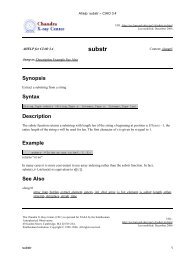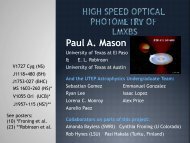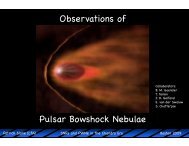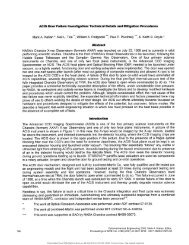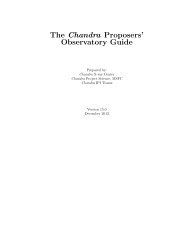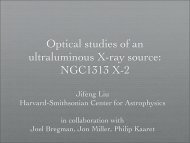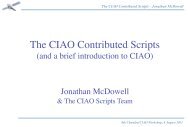Paper Title - Chandra X-Ray Observatory (CXC)
Paper Title - Chandra X-Ray Observatory (CXC)
Paper Title - Chandra X-Ray Observatory (CXC)
Create successful ePaper yourself
Turn your PDF publications into a flip-book with our unique Google optimized e-Paper software.
Fig. 5. Maximum allowed dwell times by Ra and Dec for late 2007. Plot generated with constraint integration tool,<br />
which also outputs delimited text files for processing and import into other tools.<br />
3. Fast Turn-Around Scheduling<br />
3.1. Targets of Opportunity<br />
Target of Opportunity (TOO) observations can have requested turnaround times ranging from hours to<br />
months. Any TOO with a requested turnaround time greater than three weeks is incorporated into the<br />
nominal weekly scheduling process. For observations requested to occur within three weeks, extra effort is<br />
required to schedule them. If the load set where the TOO will be placed has not yet been uplinked to the<br />
spacecraft, the Mission Planner uses the ORViewer to incorporate the TOO into their observing plan and<br />
goes through the nominal scheduling process at an accelerated pace. The scheduler’s goal is to disturb as<br />
little of the original observing plan as possible, which minimizes the effort required to incorporate the TOO<br />
and the chance for introducing errors. However, when inserting a TOO observation, something must be<br />
removed from the schedule. ORs with time constraints or those coordinated with other observatories are<br />
removed only as a last resort. So the scheduler must balance keeping the schedule intact with ensuring that<br />
only unconstrained observations are removed. This is generally achieved through close coordination<br />
between flight team schedulers and science mission planners.<br />
If the requested turnaround time places the TOO observation within the week running on the spacecraft, the<br />
running loads must be interrupted and replaced with a new observing plan. Fast turn-around scheduling that<br />
replaces the running loads is referred to as a “re-plan”. In order to provide fast turnaround times, flight and<br />
science team schedulers are on-call 24 hours a day. An automated email system sends messages to pagers<br />
and cell phones alerting the planners to a fast turnaround re-plan. Science mission planning immediately<br />
starts to coordinate with the Director’s Office, science instrument teams and observer to finalize the<br />
parameters of the observation as quickly as possible. While this happens, flight mission planning takes the<br />
information they have (generally target and turn-around time) and generates a straw-man schedule.



